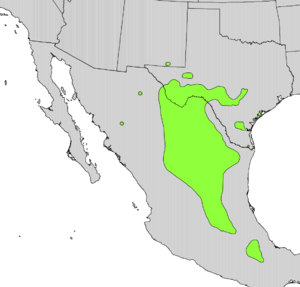Dermatophyllum secundiflorum facts for kids
Quick facts for kids Dermatophyllum secundiflorum |
|
|---|---|
 |
|
| Dermatophyllum secundiflorum flowers and leaves | |
| Scientific classification | |
| Kingdom: | |
| (unranked): | |
| (unranked): | |
| (unranked): | |
| Order: | |
| Family: | |
| Genus: | |
| Species: |
D. secundiflorum
|
| Binomial name | |
| Dermatophyllum secundiflorum (Ortega) Gandhi & Reveal
|
|
 |
|
| Natural range | |
| Synonyms | |
|
|
Dermatophyllum secundiflorum is a species of flowering shrub or small tree in the pea family, Fabaceae, that is native to the southwestern United States (Texas, New Mexico) and Mexico (Chihuahua and Coahuila south to Hidalgo, Puebla and Querétaro). Common names include Texas mountain laurel, Texas mescalbean, frijolito, and frijolillo.
Contents
Name
Although "mescalbean" is among the plant's common appellations, it bears no relation to the Agave species used to make the spirit mezcal, nor to the peyote cactus (Lophophora williamsii).
Description
An evergreen, its leaves are pinnately compound, with small, roughly spatulate leaflets; the leaflets are rather thick, and waxy to the touch. Never tall, and rarely having a straight trunk, its bark is smooth in all but the oldest specimens. It grows slowly to a height of 15 ft (4.6 m) and a crown diameter of 10 ft (3.0 m).
Extremely fragrant purple flowers, resembling the smell of grape soda, are produced in large clusters in March and April. They are followed by 4 in (10 cm) pods containing deep orange seeds.
Habitat
It is well-adapted to arid and semi-arid habitats but is most common in riparian zones.
Uses
Dermatophyllum secundiflorum is a popular ornamental plant due to its showy flowers and orange seeds. The reddish wood it produces is potentially useful, but as yet has little commercial value.
The beans were once used by some Native American tribes for religious ceremonies.
See also
 In Spanish: Frijolito de Texas para niños
In Spanish: Frijolito de Texas para niños

